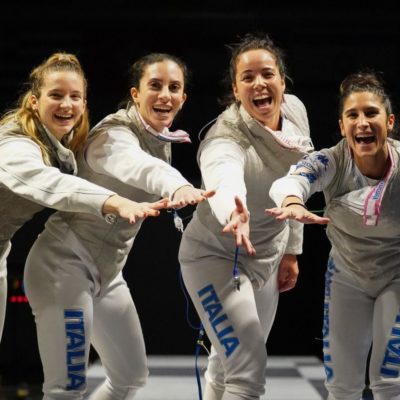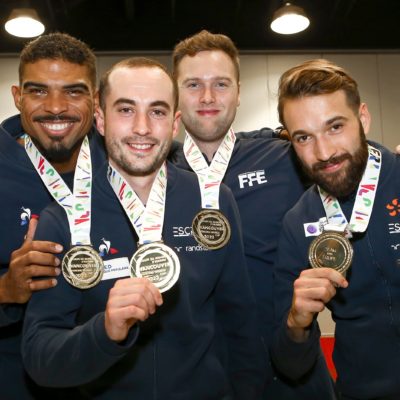At the Athens2004.com website, the bracket of 64 is loaded and ready to go. Many top fencers are getting byes to the round of 32, including Dan Kellner USA (25th seed). Jedediah Dupree USA (29th seed) and Jonathan Tiomkin USA (32nd seed), however, face a fight from the get-go. The good news for them — both have a edge over their opponents. The bad news for Dan Kellner — he’s meeting a top fencer in the round of 32, 8th-seed Cedric Gohy BEL, who also has a bye.
American Prospects
Jonathan Tiompkin has drawn 33rd-ranked Maher Ben Aziza TUN, a Tunisian fencer who underweighs him by 30 pounds. When Tiompkin gets going, his game is very physical and mobile on the strip, and he may be able to power his way through the bout. Tunisia, a traditional fencing non-powerhouse, is nonetheless a short hop from the EU and has strong ties to France. Therefore, Tunisian fencers could be very capable, and Tunisia has qualified 5 fencers despite drawing from a population the size of New York City. Ben Aziza qualified for the Olympics based on his FIE rank, so Tiompkin is facing a very experienced fencer (an Olympic veteran) whose technical skills may not be on par with Tiompkin’s.
If Tiompkin enters the round of 32, he gets to meet 1st-seed Andrea Cassara ITA. You can see Cassara, master of the Italian march, in this video clip where he’s trying not to be too hard on France’s Sebastien Coutant (23rd in 2003 World Champs). Meeting Cassara in the 32 is the fencing equivalent of meeting a brick wall at 50 miles per hour, and the wall is covered with poison and satanic graffiti. Cassara is tremendously strong, and a good pick to win the Gold. Still, fencing is fencing, and Tiompkin can upset Cassara with a tenacious, tight, and direct game; it won’t be pretty but Tiompkin can ignore the “implied” threat of Cassara’s march and use his considerable speed and power to first frustrate, and then tick off the Italian.
Jed Dupree, for his part, has a clear advantage over his opponent, 36th-seed Sofiane El Azizi ALG. El Azizi is a zonal qualifier, and finished 100th in the 2003 World Championships (Dupree finished 38th). Dupree is bigger by 20 lbs, has better results, great coaches (Kogler, Leach, Gershon), and probably more experience.
Look for Dupree to finish off his opponent quickly and get a morale boost for his next bout with 4th-seed Brice Guyart FRA. Guyart’s accomplishments are considerable: Third in the 2003 and 2001 World Championships, Gold Medal Team Foil in the 2000 Olympics, over a dozen world medals in the last four years.
Dan Kellner’s plan for Dupree, when they were in the semi-finals in the 2004 USA Nationals, was to leave his tip out and let Dupree run onto it. With a lot of drama, this was what happened. France is tip, and high French point technique can make everyone else look geriatric. If Dupree can follow the lead of the Germans and Italians when they fence the French, he will protect his long attacks with impenetrable preparations to land touches from “far away.” The moment Guyart is able to activate his own technique, the sophistication scale slams down on France’s side. This will be a hard fight, with Guyart’s strength being one of Dupree’s weaknesses (and vice versa!).
Dan Kellner gets a bye (a bye is a free pass) into the 32, where he meets 8th-seed Cedric Gohy BEL. Gohy finished 10th at the 2003 World Championships (Kellner finished 59th), but Kellner’s confidence should be high based on his results this year, and when he gets going he’s very dangerous. Those 2003 World Championships results don’t mean much when it comes to Kellner — Joao Gomez POR finished 17th, 42 places ahead of Kellner, but Kellner had already beaten him at the Venezuela World Cup. Kellner can play with the best; 2nd-ranked Salvatore Sanzo ITA only beat him by a few points in Venezuela, and he fenced Kellner more timidly than he fenced Ralf Bissdorf GER.
When Kellner claws past Gohy, he will meet the winner of Haibin Wang CHN versus Richard Kruse GBR. 24th-seed Kruse was 8th in the World last year, while 9th-seed Wang was 12th in the world. In round 32, their rankings are reversed, but both are likely to give Kellner a Gohy-like run for his money. To get into the round of 8, Kellner will have to face bracket favorites Andre Wessels GER (17th seed) or Andrea Cassara ITA.
Overall
The Italians (Andrea Cassara, Salvatore Sanzo, Simone Vanni, 1-3 seed) will medal once and possibly twice, having the 1st- and 2nd-seed on opposite sides of the bracket. The Germans (Andre Wessels, Peter Joppich, Ralf Bissdorf) are almost equally matched, and the French (Loic Attelly, Brice Guyart, Erwan le Pechoux) almost always sneak someone into the top 4. Potential upsets may come from a young Russian squad — Renal Ganeev, Rouslan Nassiboulline, Youri Molchan, who have a few results between them — and of course the Chinese and Koreans.
Bouts to watch for:
In the round of 32, 16th-seed Andre Wessels GER versus 17th-seed Hee Kyung Park KOR. These closely-seeded competitors will have a hard fight with interesting stylistic differences. Wessels will be fencing to maintain his standing, while Park will be fencing to overcome.
In the round of 16, Andrea Cassara ITA versus Andre Wessels GER. Cassara has great marches, while Wessels seems to be in transition towards oppositional bladework and tip-hits, while still marching. These two are only meeting each other because Wessels’s seed is so low. We bet that Andrea Cassara ITA will beat Andre Wessels GER, Cassara being at the top of his game and Wessels having few results in 2004.
Predictions
Barring upsets, Peter Joppich GER, Simone Vanni ITA, Ralf Bissdorf GER, and Salvatore Sanzo ITA will walk into the round of 8.
When the dust settles from the closer bouts in the round of 16, the next three fencers will be 7th-seed Hanxiong Wu CHN, Brice Guyart FRA, and Andrea Cassara ITA. The last spot is Dan Kellner’s bracket, which is tough to call… if Kellner beats Cedric Gohy BEL, he will defeat Haibin Wang CHN/Richard Kruse GBR, and enter the top 8. If Kellner falls to Gohy, then Gohy will enter the top 8.
The semi-finals will see two Italians, a German, and a Frenchman fighting for dominance.
End of an era
After the Olympics, the new box-timing changes will come into effect. These Olympic games will showcase the high-water mark of ballistic foil. The mechanics of flicks, marches, and pulled-hand attacks will never again be as distinct, and the tactics of implied threat will never again be as compelling. It is the end of an era; next year, the international rankings will twitch interestingly as some foil techniques fade in usefulness and others grow. In this Olympics, watch the Italians for the best marches; watch the Germans for their march-breaking and new tip-based ideas; watch Russia to see what their next generation looks like; watch China because they are an emerging powerhouse.





